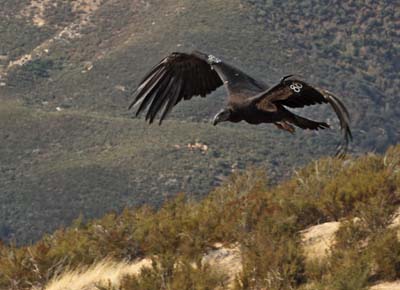California Condor No. 588 wasted little time making himself
right at home in his new environment after taking to the air for
the first time Saturday. But he had a little help.
California Condor No. 588 wasted little time making himself right at home in his new environment after taking to the air for the first time Saturday. But he had a little help.
The newest “wasaka,” the name the Amah Mutsun Tribe has for the condor, made his spectacular entrance during the Condor Comeback event at the Pinnacles National Monument.
About 250 people watched on screens from the visitors center as the condor release was broadcasted from the remote staging area. The crowd hushed in anticipation as No. 588, and his “guide” No. 547 took a tentative step toward the top of the just opened pen.
As the cage door was opened, the birds hopped around eagerly looking for a way out, sensing their approaching freedom. They half jumped and half flew through the opening at the top of the cage and perched briefly on the top as the crowd applauded. Fellow birds both in captivity in a separate portion of the cage and free birds that were hanging out looking for food seemed to also be rooting for their fellow avian companions. The birds hopped up to a post on the top the cage to get a better vantage point of their new home before flying off shortly after.
“He (No. 588) is a very healthy bird and was our No. 1 candidate for release today,” said Daniel George, the condor program manager. “He is feeding really well and has put on a lot of weight since he has been in captivity. He seems like a very strong bird. His personality has always been very strong as well – curious.”
Staff will leave carcasses out during the night for the birds to feast on, making sure they don’t become too friendly with humans. Sometimes they will include fine wild pig delicacies that have been shot by staff with lead-free ammunition. Because of the threat of lead poisoning, hunters are required to use non-toxic ammunition.
Condor No. 547, which is about 2.5 years old, was selected to be a guide for the 18-month-old No. 588 after being brought in for a biannual health check.
“They are very gregarious and will spend time with other condors,” George said. “We had hoped that it would transpire that we had a free-flyer with the juvenile. We haven’t had the opportunity many times. We had hoped it would give him some sort of guidance on what to do and become curious about his surroundings.”
In the past, some birds have sometimes been reluctant to leave the cage. But that was not the case this year.
“I can’t believe how cooperative they were,” said biologist Gavin Emmons, who has been with the Pinnacles for nine years. “Every time we release one of these birds, it adds one more to the population, which is currently about 400 worldwide.”
“They know how to perform for the cameras,” one audience member said.
No. 588 was brought in from the Peregrine Fund in Boise, Idaho, which has a large aviary where the birds can fly around, to be released at the Pinnacles. Both birds were successfully returned to the wild Saturday. There was some initial concern about where No. 588. had flown off to. But after testing his wings, he returned to the pen, George said on Sunday.
A handful of visitors had the chance to join staff and volunteers to take a hike after the release to an area where they could get a closer look at the birds through telescopes.
Betty Morrissey, who along with her husband, came from Orange County to camp and hike not knowing about the condor release. Betty decided to check out the event to get a chance to see a condor for the first time.
“I got a lot more out of it than I thought I would,” Betty said. “I learned a lot about the condor. They are beautiful. When they said they were going to do a release, I thought it would be four or five people standing around. It was fun to check out an area you normally wouldn’t have access to.”
Volunteers and staff place a radio transmitter on the bird to track the location. With a portable antenna and receiver they can get a signal from a bird up to 40 miles away. A person holds the antenna out over his head and slowly rotates it around. A beep indicates there is a bird in that general direction. The beep gets stronger when the antenna is pointed closet to the bird. The number of the bird will display on a screen.
“On a more normal day we hike up to a prominent area where we could get a signal coverage,” volunteer Joseph Belli said. “We go through every one of the birds in the Central California flock. There are about 55 or so. About once an hour we try to get a signal for those birds or as many as we could get. That gives us a good ideas of its activity and movement.”
Volunteer Richard Neidhardt was first introduced to the program in March 2010 after seeing an egg swap while hiking on the Juniper Canyon Trail on the west side of the Pinnacles. Eggs are replaced with wooden eggs to make sure they are preserved and hatch properly. After watching the Pinnacle biologist rappellers through a telescope, he was instantly hooked and knew that he wanted to be a volunteer. He spends one week each month working with the condors.
“I was just beside myself; I was so excited,” he said. “Volunteering has undoubtedly been one of the most satisfying things I have done in my life. I know I’m not a real biologist, but for week a month I feel like one.”
The condor has a special place in Native American history.
“The birds are messengers between us here on earth and the Creator,” said Val Lopez, the tribal chairman of the Amah Mutsun tribe. “Because the condor flies the highest, he carries our message closest to our Creator. He also communicated with our ancestors in the past.”
Marvin Marine, of the Ohlone and Maidu tribe, led the crowd in a traditional Native American prayer chant, and Lopez offered a blessing before the release.
“May its life be long,” Lopez prayed. “May it successfully meet its trials and tribulations. May it find a mate and raise new baby wasaka.
“May it be a good parent and teach those baby wasakas well so that in the future they can once again populate the lands of California where they are indigenous to. May they be restored to health. That right there is the responsibility of all of us here today to ensure that their life goes forth in a positive and strong way.”
The event was scheduled to coincide with the National Public Lands Day, a day when fees are waived at all national parks.
“Thinking about the condors gets me very excited and emotional,” said Veronica Johnson, the volunteer coordinator. “There are close to 200,000 people who are volunteering on the public land and doing service. By being here you are doing service to the public lands. You are educating yourself, inspiring yourself and telling others about the plight of the condor.”
Superintendent Karen Beppler-Dorn, who joined the park in January, said she was excited to be a part of her first condor release at the Pinnacles.
“I’d like to think that we are coming together as a community affair, that the folks here today care about our earth, our planet and our animals and all that exists today,” Beppler-Dorn said. “And that we care about this very special bird that is a symbol. Just like the Phoenix, the condor is rising from the ashes of near extinction.”
To volunteer
The Pinnacles, which had about 800 volunteers last year, will hold volunteer training in November for people interested in helping with condors. Details: (831)389-4486 ext. 242 or nps.gov/pinn/supportyourpark/
volunteer.htm.










